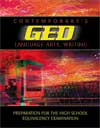|
 |  Contemporary's GED Language Arts, Writing Ellen Carley Frechette
Tim Collins
Combining Sentences
Chapter OutlineStudy the chapter outline below. Use the page numbers below each topic to refer to the corresponding section in Contemporary's GED Language Arts, Writing. When you are finished, go to the Flashcards or choose a different activity or chapter from the menu on the left.
Compound Sentences
(See pages 83–85)
-
A compound sentence contains two independent clauses joined by a coordinating conjunction.
-
A clause is a group of words that contains both a subject and a verb.
-
An independent clause can stand alone as a complete sentence.
- Coordinating conjunctions (like and, but, yet, so, or, nor, and for) join elements of equal rank. The conjunction must show the correct relationship between the two clauses and should be preceded by a comma.
|
 |  |  | Run-on Sentences
(See page 86)
-
A run-on sentence contains too many thoughts or strings together too many clauses without conjunctions.
-
To fix a run-on, break it up into two or more sentences or add a comma and a conjunction.
|
 |  |  | Commas with "and"
(See pages 87 and 88)
-
Use a comma before and if it connects two independent clauses.
-
Use a comma before and in a series of three or more compound elements.
-
DO NOT use a comma with and if it connects only two compound elements.
|
 |  |  | Complex Sentences
(See pages 89–93)
-
A complex sentence contains a dependent clause connected to an independent clause by a subordinating conjunction.
-
An independent clause can stand alone as a complete sentence, but a dependent clause cannot.
-
The conjunction must show the correct relationship between the two clauses:
-
Time relationship: before, while, as soon as
-
Cause and effect or purpose: because, since, so that
-
Condition: if, unless, whether
-
Contrast: although, whereas
-
Similarity: as if
-
Place: wherever
-
If the dependent clause comes before the independent clause, place a comma before the independent clause.
-
If the independent clause comes before the dependent clause, do not use a comma.
|
 |  |  | Dependent Clauses in a Paragraph
(See page 94 and 95)
-
Sentence fragments are often dependent clauses standing alone.
-
In a paragraph you can fix such a fragment by connecting it to an independent clause.
-
Any clause that begins with a subordinating conjunction must be attached to an independent clause.
|
 |  |  | Comma Splices
(See page 96)
-
A comma splice is an error in which two clauses are incorrectly joined by a comma without a conjunction.
-
Make sure the linking word you use is really a conjunction. For example, the word however is not a conjunction.
|
|
|



 2002 McGraw-Hill Higher Education
2002 McGraw-Hill Higher Education